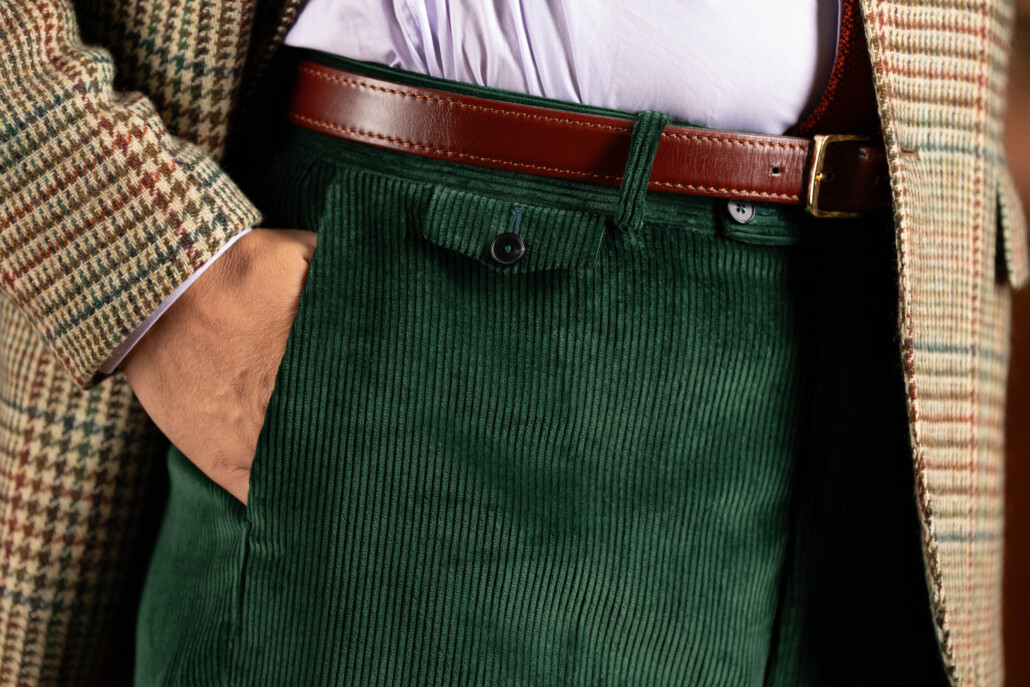Have you overly wondered why corduroy trousers come in such variegated price ranges, and whether one is largest than the other? Corduroy is the ultimate old-money pair of trousers that exudes a laid-back elegance. They’re comfortable, they have a tomfool look, and they can alimony you warm. But, do you really have to pay a king’s ransom to get a decent pair of corduroy pants? That’s what we’ll examine today.
What is Corduroy?
First of all, what on earth is corduroy? Comparatively speaking, most fabric is woven in a straightforward way. Think of your wool suiting, your tweed, or your cotton chino fabrics. These are just woven and you end up with one layer of fabric that is then finished and, voila, you have the final product.
At the core, corduroy is velvet that has ridges cut out. So, how much do you have to pay for corduroy trousers? Basically, you can get unseemly undear stuff at mega retailers like Target and you’ll find stuff probably in the $30 to $40 range. Then the next step up, there are brands like LL Bean or Brooks Brothers, where you can find things in the $70 to $80 range. Furthermore, you have brands like Polo Ralph Lauren, which have established themselves considering of their really unconfined styling, so they’ll tuition more, so you’ll get them at like $200.
As you use a increasingly high-quality fabric and have increasingly special details and a increasingly refined cut, you’ll find price points increasingly than a $300, $350, maybe $400 range or increasingly if you go made-to-measure or custom.
Cheap vs. Expensive: Corduroys
In today’s video, we’ll squint at a pair of LL Bean corduroy pants, which retail for $69.95, and compare them to a $295 pair from Fort Belvedere to fully understand what the differences are, if it’s worth paying increasingly than four times the price, and what you get so you know how you can weightier invest your hard-earned money.
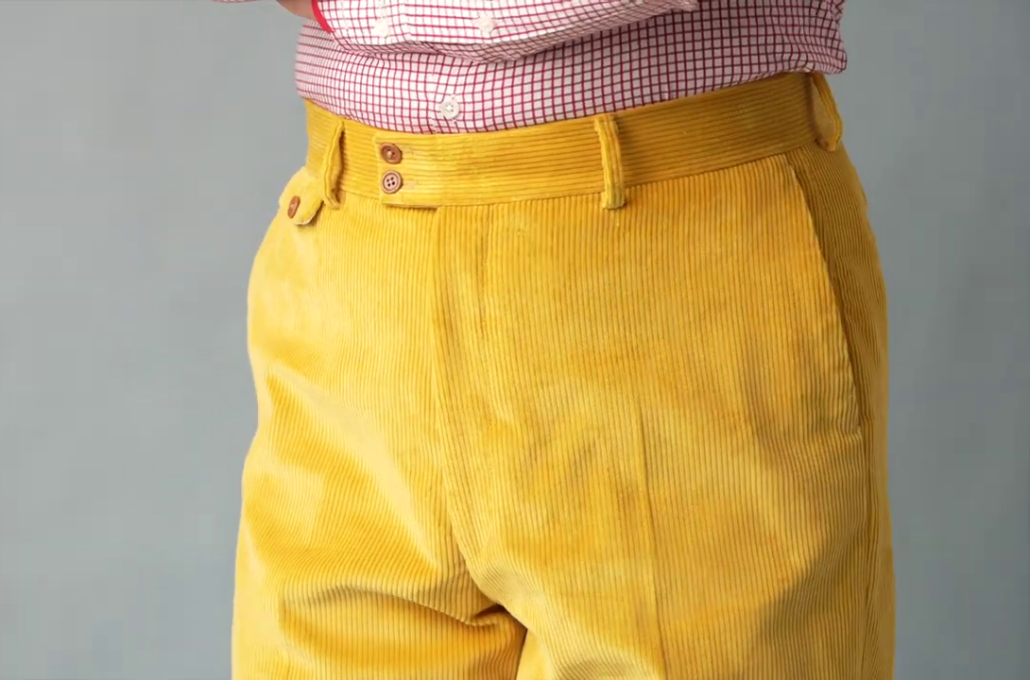
LL Bean Corduroy at $69.99
Why not compare a lower-cost pair at $30 to $40? Well, at that point, you just have to make so many compromises that the comparison is really not one that is super helpful.
Fabric
First, let’s talk well-nigh fabric: fabric on an expensive pair of pants will have the majority of the forfeit than on the lower end. If you really get unseemly fabric, the manufacturing forfeit may be higher than the fabric itself. When you buy a pair of corduroys for $69.95 retail price, you will have to make sacrifices on the quality of the fabric. There’s no way virtually that. Otherwise, you could not sell it at this price profitably.
Natural fabrics like cotton stretched with spare synthetics are typical on cheaper corduroys.
Typically, corduroys are made with some percentage of cotton. Sometimes, they’re poly-cotton, which is less expensive; sometimes, they use recycled cotton or 100% cotton, but plane if you do that, not all cotton is alike.
Cotton is a natural webbing that has variegated staple lengths, and it moreover depends on the yarn quality that you make it into. Is it a two-ply yarn? Is it a four-ply yarn? Is it very strong? What’s the luster of yarn? All these things come together.
So, plane if two pairs are 100% cotton, the quality, the durability, the feel, and the luster may be entirely different. If you’ve been pursuit us at the Gentleman’s Gazette, you know that we’re big proponents of natural fibers.
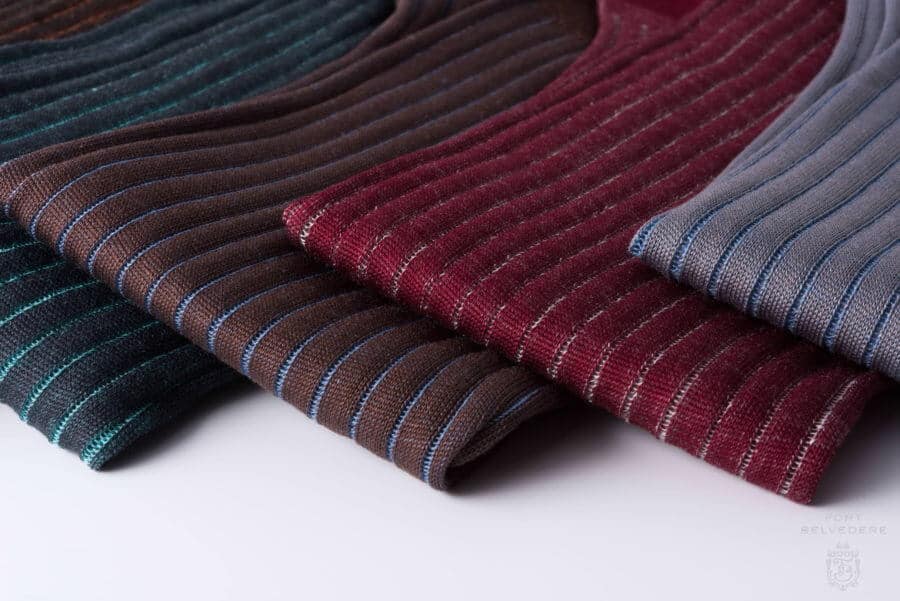
Shadow Stripes Socks made of Cotton Fil d Ecosse – Fort Belvedere
Why? Well, they’ve proven over time that they’re really nice to wear. You don’t have to worry well-nigh anything leaking into your body, and they just finger largest and outbreathe better. They’re increasingly well-appointed at the end of the day.
Fabric Type
So our $70 LL Bean pair here is made of 98% cotton and 2% spandex. There’s not much increasingly information well-nigh it, so we have to send it to a lab to unquestionably do tests to see how many double rubs it can withstand surpassing it breaks.
Our $295 pair of corduroys is made out of 100% cotton that is rather heavy. It has a trappy luster and it has a double rub rating of 20,000, which is a really good rating plane for polyester fabric. So, when you wear these pants, you know that you can wear them for years to come, which ways it’s automatically greener considering you’re not producing cotton over and over and over then and just throwing it, but everything that’s needed, all the chemicals in the finishing process are just used once, and you can wear those pants for a decade or longer.
Personally, I haven’t seen how the LL Bean fabric was woven, but the warp count per inch is going to be a lot lower than on the $295 Fort Belvedere pants. Why does it matter? A higher warp count is increasingly plush in the weaving process, but it moreover yields a superior, increasingly durable fabric.
When it comes to the overall weight, heavier doesn’t unchangingly midpoint increasingly expensive; however, if you have a upper warp count fabric, then a heavier fabric is definitely going to be increasingly expensive.
Fabric Nap
Another thing that will be really variegated between the two pairs of pants is the fabric nap. When it comes to corduroy pants, you have this nap that goes in two different, distinctive directions.
When you skim the corduroy down, you have this soft, shimmering, and mesmerizing surface; if you skim it up, plane with your hand, you can once finger that you get a rougher, increasingly textured surface.
Cheap Corduroy
Nap Holes
On cheaper corduroy pants, this nap will deteriorate much quicker over time. You will see that there are areas where the material comes out, and you see scrutinizingly little holes in that nap.
On the expensive pair of corduroys, it’s going to stay like that for a much longer time. Also, when you get really unseemly corduroy pants, sometimes what happens is that, on the front side, the nap direction is top-down, and on the when side, it’s bottom-up—meaning the pants just don’t squint right.
On the LL Bean pair, they at least got the nap all in the right direction. But if you compare the LL Bean on the left to the Fort Belvedere on the right, you can see a well-spoken difference with these pants just by hanging them side by side. The LL Bean one looks fuzzier, looks increasingly matte, and is just not nearly as lustrous as the Fort Belvedere one.
Visually comparing LL Bean and Fort Belvedere Corduroys
This becomes particularly obvious when there are wrinkles in the pants and, as you walk, there are going to be a lot of wrinkles as you sit. Just see how the wrinkle reacts to the light on the Fort Belvedere versus on the LL Bean.
Fabric Production
Typically, cheaper pants are moreover made in countries with a lower forfeit structure. So, the LL Bean pants are made in China, probably from Chinese fabric. The Fort Belvedere pants are made in Western Europe, in Portugal, and are made of fabric that is made in Italy.
Does “Made In” Matter? Countries of Origin for Menswear Products
When it comes to corduroy fabric, the two big powerhouses are English corduroys and Italian corduroys. Typically, the difference between them is that the English ones are a bit stiffer—they are often a bit firmer—and the Italian ones are increasingly fluid and smoother.
These Fort Belvedere trousers try to combine the weightier of both worlds. It is a heavier, denser fabric that is like an English corduroy with a finishing and fluidity of increasingly of an Italian corduroy.
Fort Belvedere corduroy combines the unconfined qualities of English and Italian corduroys.
Fabric Weight
There’s moreover a big difference in the weaving density and the weight of the fabric. You can get quality corduroy fabrics that are lightweight, and you can see some that are heavyweight. So, you should get the right kind of fabric for your purpose and climate.
The pair of LL Bean pants in size 38×32 weighs 716g, which is well-nigh 25 and 1/4oz. The Fort Belvedere corduroy in a size 38 waist with an inseam of 31, it’s a little shorter, and weighs in at 984 g or 34.7oz. So, that’s a substantial difference in weight of over 30%.
The Fort Belvedere Corduroy (left) weighs significantly higher than the LL Bean (right).
When it comes to fabric, they typically come in a weight measurement. That is typically the width of the fabric, which is well-nigh 150cm, and then the length, which is a yard or 1m. For most corduroy pants, you need between 1 and ½ and 1.7m of fabric. So, if you multiply that and you add things like the buttons and the trimmings, you come to a unrepealable weight.
So, over the last two years, I tested probably 20 variegated corduroy weights, starting at a low end at well-nigh 325g per running meter, all the way up to 825g per running meter. My favorite fabric weight was 705g for the meter because, while it was still heavy and warm and comfortable, the physical feedback was much less pronounced, and it was much increasingly pleasant to wear those. So, the Fort Belvedere corduroy is made of this 75g weight.
Discover increasingly fabrics!
Break-in Period
Of course, when you put in a pair of corduroys for the first time, the fabric will be somewhat different, but as you wash them (and I suggest you wash them inside out), you’ll get a softer fabric that feels extremely well-appointed over time. It’s basically like a short safecracking period for your trousers. But, with Fort Belvedere trousers, that is not the case. There’s no real big safecracking period. Also, with the LL Bean one, there’s not a big safecracking period. It feels rather soft out of the box.
Drape of Fort Belvedere pants
When you have the pants on, you can unmistakably see the difference though. The sprawl of the LL Bean pants is much junior to the Fort Belvedere pants. Also, the finger on the inside as well as the outside of the LL Bean pants is much junior to the Fort Belvedere pants. It’s stiffer. It’s flimsier. It’s just unexciting.
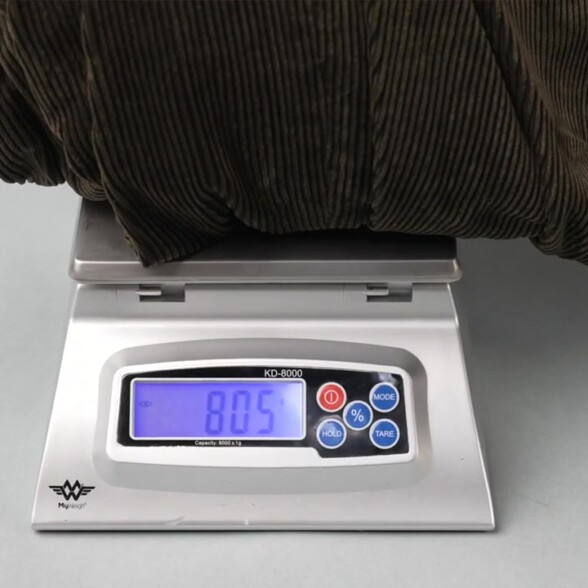
Weight of expensive corduroy
Ralph Lauren
Out of curiosity, I weighed my Polo Ralph Lauren trousers, which are the same size and have the same inseam, and weigh 805g. That’s well-nigh 28 and a half oz. It moreover has the same wale, which ways the same size of ridge as the Fort Belvedere one, and it’s a little higher quality in finger than the LL Bean pair of pants. But it is a noticeably stiffer feel, not as luxurious, not as heavy as the Fort Belvedere one.
Durability
I think the pants I had the longest are the Polo Ralph Lauren ones. They’ve definitely shown some wear, expressly in the crotch zone for me considering I have big thighs. But moreover in other areas of the pants.
The LL Bean ones are relatively new, so I haven’t seen them wear out at all yet. But, I’m pretty unrepealable they will wear out at a much older point in time. First of all, considering it’s a lighter-weight fabric and, at $70, you cannot make a fabric with a super upper double rub count that is well-appointed to wear in a pair of trousers.
The Fort Belvedere ones I’ve worn for a year. I’ve washed them many, many times to see how they behave and perform, and I haven’t seen any signs of white-haired yet. I can probably wear them for ten years, maybe 12 years or 15 years. So, I still have a lot of time superiority of me to test to see when they finally wear out. You may also read this: Are Timberland Boots Worth It? (American Work Boot Review)
Ralph Lauren corduroy showing damage.
LL Bean corduroy showing wear
Fort Belvedere codruroy not showing signs of wear without a year!
Something you typically moreover see in a fabric with a lower density of warp threads is that they will tuft out in areas and won’t alimony their shape as well as a higher-end fabric will. Of course, that’s all a theory, and we can only see how they truly hold up in years to come.
Because manufacturers don’t want to wait for 15 years and wear trousers until they understand how long fabric will unquestionably last, there is something tabbed a “double rub test.” It’s moreover known as the “Wyzenbeek Abrasion Test,” and it’s really popular in the upholstery industry.
- Super heavy-duty (15,000 or whilom double rubs) – This would be used in high-traffic areas such as restaurants or maybe airports. That one is moreover suitable for having kids and dogs and animals that are really nonflexible on fabric.
- Medium-duty (9,000 to 15,000 double rubs) – This would be good for, let’s say, living room furniture.
- Light-duty (3,000 to 9,000 double rubs) – This is largest for occasional furniture
- Under 3,000 double rubs – This is typically an junior fabric.
Wyzenbeck Abrasion Test
The 825g fabric that we tested had 40,000 double rubs, so it’s extremely durable, and you could undeniability them “forever pants.” The fabric at 705g that’s used for the Fort Belvedere pants still has a rating of 20,000 double rubs, which is whilom the heavy-duty categorization. So, this is moreover a pair of pants that will last you a very, very long time. It won’t be as long as the 825g pants, but it’s a lot increasingly well-appointed to wear.
Sadly, the LL Bean pants don’t mention anything well-nigh the double rub rating, but I would guess it’s increasingly in the 3,000 to 5,000 range.
Wale Size
If you squint at the LL Bean cords and the Fort Belvedere cords, you can see there’s a difference in the size of the cord, which is tabbed “wale.”
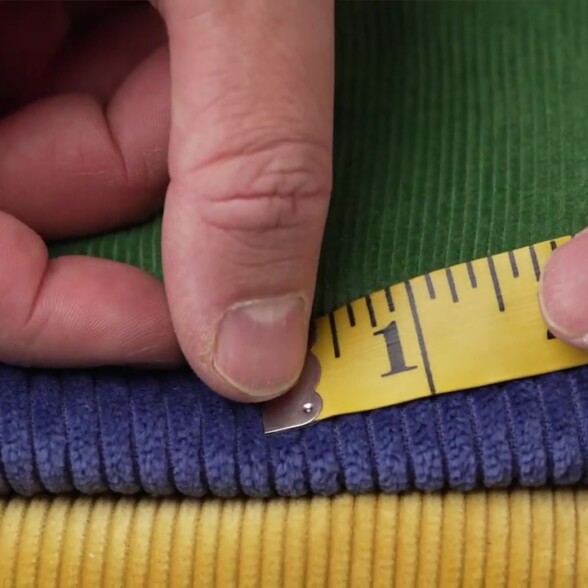
Fabric Cord
Ridge or Wale
A four-wale string ways there are four string ridges per inch or 2.54cm. Typically, for menswear pants, you’ll find anything from an 8-wale string to maybe a 12-wale cord, or sometimes, 14, 16, or more. Once you go to a four-wale cord, you get a squint resembling a grandma’s sofa.
The eight-wale string is the most popular wale size for classic menswear. If you look, the Polo Ralph Lauren corduroys are an eight-wale cord; the Fort Belvedere pants are an 8-wale cord; and only the LL Bean ones are a little slimmer. The LL Bean pants have an 11-wale cord.
Color Options
One big difference between the cheaper corduroy and the increasingly expensive corduroy is the verisimilitude options that you get. On the LL Bean website, they have four colors: one stuff asphalt, which is a gray; then a visionless charcoal, which looks scrutinizingly black; a khaki color; and a sepia color, which is kind of a mid-brown.
Fort Belvedere, on the other hand, comes in 14 variegated colors. So, no matter if you want something archetype in a brown family, something increasingly in the undecorous family, or unusual things like yellow, red, green, or blue, we have it.
Fort Belvedere corduroy pants come in 14 colors!
There are variegated ways to verisimilitude garments. First of all, you could dye the fiber. This is typically washed-up if you want a mottled verisimilitude effect. Then, you could dye the yarn; then, you can dye the fabric; and then, you can dye the unshortened garment. Typically, in a garment that is webbing dyed, you do that considering you have multiple variegated colors in the fiber, then you twist the yarn, and you get this nice melange effect. That is typically the most expensive. However, if you want consistency in a solid color, it is often yarn-dyed or fabric-dyed. Of course, from a production point of view, just having one yarn color, making the same stuff, and then coloring it in variegated colors is much increasingly cost-efficient.
How to Use the Verisimilitude Wheel to Assemble Superior Outfits
Fortunately, the dying chemicals and technology are so wide these days that you probably don’t have to worry well-nigh the verisimilitude rubbing off or stuff inconsistent over time.
If you squint at the LL Bean pair and the Fort Belvedere pair side by side—and you can plane throw in the Polo pair—you can definitely see that the Fort Belvedere colors are the most vivid and rich.
Fit & Features
Another big difference between a increasingly expensive pair of corduroys and cheaper corduroys is typically the fit and the features. These days, most pants come in a medium to low rise, and they’re based on standard patterns. When you go with increasingly expensive brands, you typically get increasingly thought-through patterns with increasingly special features and a fit that is probably different.
Some corduroy pants forfeit increasingly considering of the fit, and other thoughtful details.
Over the years, I’ve tested many corduroys, and my big rencontre was that my thighs were often too big for the pants, therefore making them not really comfortable. If I found something that was big unbearable in the thigh, it was too wide in the hem, and, overall, the proportions were off.
The LL Bean pants have what I would undeniability a “midrise,” higher than what you would get from a malleate trademark like H&M, but the cut is somewhat unflattering. It’s a straight leg. It does fit me off-the-rack, which is nice, but the hem, it’s all a bit uninspiring. It’s advertised as “Stretch Country Corduroy,” and considering of that, it has like an rubberband waistband, which reminds me increasingly of grandpa clothes. Also, I can tell that there’s definitely some vanity sizing going on considering this feels quite roomy. I’d say I can take them in at least by 1 and ½ inches.
My Polo Ralph Lauren pants have a pleated front considering that was the only way for me to unquestionably fit into them. Their flat-front options just never fit me, so I had to go with that option. Generally, though, I think corduroy works largest with a unappetizing front considering of the vertical ridges.
The rise is a little lower than the LL Bean pants, and it’s a little tighter in the thigh. I had them hemmed with turn-ups or cuffs considering it adds a bit increasingly weight, and I think it works well with corduroy fabrics. If you wanted cuffs, you can just get the LL Bean ones in a longer size, and you can still have the cuffs made at your alterations tailor.
The LL Bean pair has rubberband waistbands.
The Ralph Lauren pair is pleated.
I moreover tried many other brands, such as Cordings, which come in a nice verisimilitude variety and have decent fabric, but their cut just never works for me. I mean, if I wear these pants, I squint like a pressed sausage. Also, I felt the hem was too wide and, by default, they came with a sawed-off fly you could upgrade to a zip fly for an spare upcharge. But, overall, those pants just never worked for me and were not plane remotely to be flattering.
So, the Fort Belvedere corduroys are variegated in a number of ways. First of all, they are the highest rise of all of them that I’ve overly tried. Why? Well, during the Golden Era of Menswear in the 1930s, men unchangingly wore high-waisted pants. They were increasingly comfortable; they sit on your natural waist, and elongate your leg line, and they indulge for a nicer sprawl of the fabric. Considering it sits in the waist, you moreover don’t have to deal with your pants sliding lanugo all day.
If you squint at the Fort Belvedere size chart, you will see that at the lower end, the hem size doesn’t get smaller because, if you do that and you wear the pants at a size 28 or a size 30, your socks will stick to your legs, and you will constantly find yourself having to pull your pants down. That’s not just worrying but moreover looks bad.
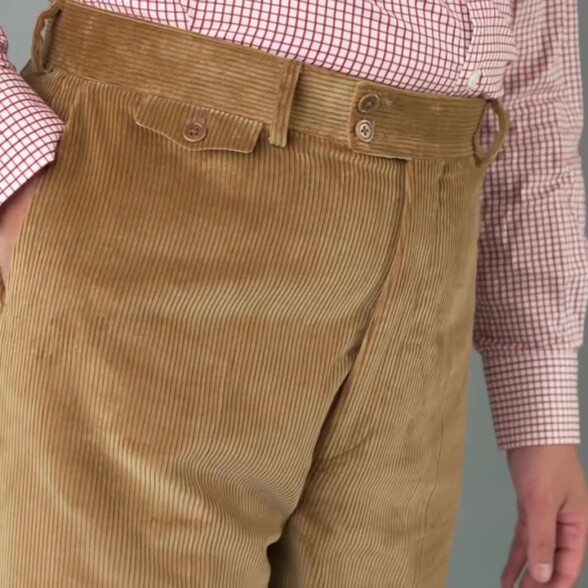
High-Waisted Pants
Roomy for Worthier Thighs
The Fort Belvedere ones finger roomy in the thigh, they’re very comfortable, but they don’t squint baggy. That’s considering they’re tapered lanugo towards the hem in a very elegant way. Basically, for most brands, they start with a wiring size, and from there, they scale up and scale down, meaning as your waist gets a little bigger, your hem gets a little bigger, your knee, your thigh, and so forth; however, that’s not what’s necessarily most flattering for people.
Also, at Fort Belvedere, you can see that the leg opening, at size 36, is the same as size 38, 40, or 42 because, at some point in time, it doesn’t make sense to make the leg opening wider. The same is true for the rise. There is a point where the rise simply gets too high, and it kind of overlaps your rib cage, which is not what you want.
If you want lower-rise trousers, I think Polo Ralph Lauren and Cordings are what you want. If you want a slightly higher-rise trousers, LL Bean is better. If you want a true high-rise trousers, Fort Belvedere is definitely the pair of corduroys to get. Also, if you have worthier thighs or you’ve had issues with fitting in your pants, the Fort Belvedere sizes are designed to be full in their cut. However, of course, if you’re a size 28 or 30 waist, you will not have really big thighs.
So, the pattern was scaled lanugo increasingly considering we moreover wanted to worth for slimmer people with thinner legs for our Fort Belvedere trouser models.
Should You Wear High-Waisted Pants?
Backings
At variegated price ranges, you typically moreover find variegated backings, which refers to what’s the inside of the corduroy trouser. That’s important considering the corduroy fabric is directly in touch with your skin, and you want it to be comfortable. All the trousers here—LL Bean, Cordings, Fort Belvedere, and Polo—have the increasingly elevated valuables with the ridges and a twill weave.
Corduroy valuables may squint the same, but softness differs.
In terms of softness, I personally prefer a really soft feel. I would rank them as: the Polo is the stiffest, followed by the LL Bean, and then Cordings and Fort Belvedere are at similar levels and are the softest.
Details
When it comes to details, there’s typically a well-spoken difference between cheaper trousers and increasingly high-end trousers.
On a cheaper end, you get very standard features. The whup loops are increasingly of an afterthought. There’s just a simple sawed-off on the front that’s very functional. There’s a zip fly, but there’s no sustentation to detail or anything that says this is a special pair of pants considering it isn’t.
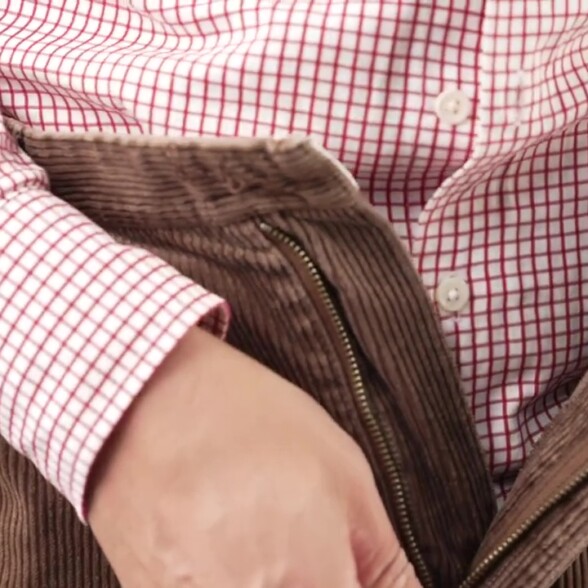
LL BEAN PANTS
Lacking Details
If you squint at the LL Bean pants, there’s a simple button. There’s no double button, no French bearer. There’s nothing that covers anything up, the whup loops are not anything special. They have this weird grandpa-style rubberband waistband, which is not something I like, but it’s typical for this price range.
The Polo pants are a slight upgrade. They have a French bearer. They have pleats in the front to get the uneaten room that I needed, but otherwise, they’re moreover not very heady or special.
The Cordings have an rubberband waistband with buttons, which, again, I’m not a super fan of. By default, they have the sawed-off fly, but you can moreover upgrade to the zip fly. If you do that, that adds $29 to the cost, and once you do it, you can’t return them anymore.
The Fort Belvedere pants have jetted pockets that are set at a very variegated wile than the LL Beans ones. It moreover has a nice little ticket pocket with a flap that is buttoned. The waistband is a little larger and features two latter buttons. Also, there’s an overlap. It’s increasingly inspired by archetype dress trousers. The idea was that you could wear a archetype dress whup but moreover a increasingly rugged unstudied whup that was a little bigger, and it would fit with the whup loops.
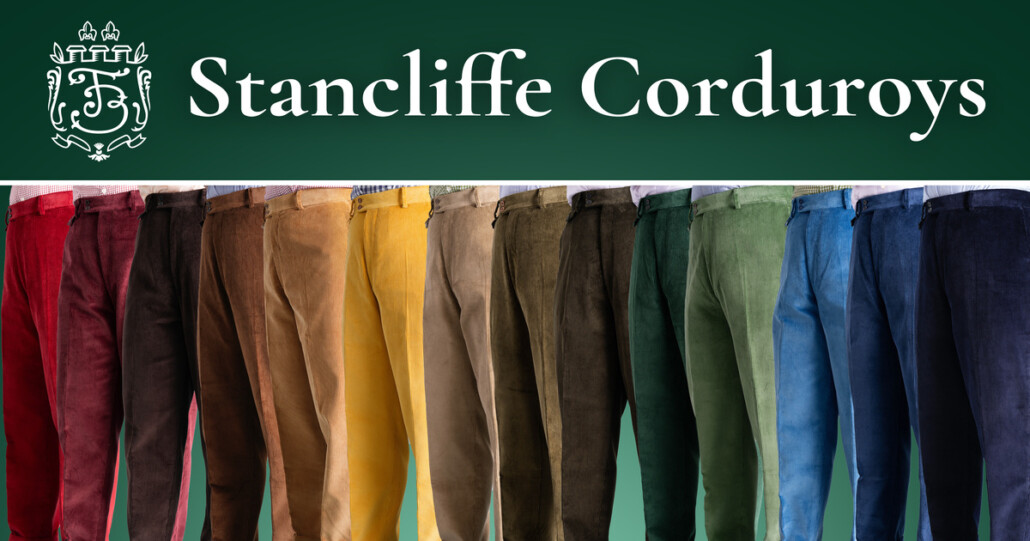
Stancliffe Flat-Front Corduroys – Fort Belvedere
The loops themselves are moreover a little preferably than what you, for example, see on LL Bean. It’s increasingly suggestive of higher quality trousers that you’ll get from a tailor. You moreover squint on the inside, and you see a lot of of differences in the details.
The LL Bean one, for example, has no room to expand the pants. You can just make them smaller, not bigger. There’s no information on the sonnet of the interior waistband and pocket lining.
On the Polo Ralph Lauren pants, there are some fabric reserves. The edges of the fabric are nicely taped, but there is moreover no information on the material of the inside of the waistband or the pocket lining.
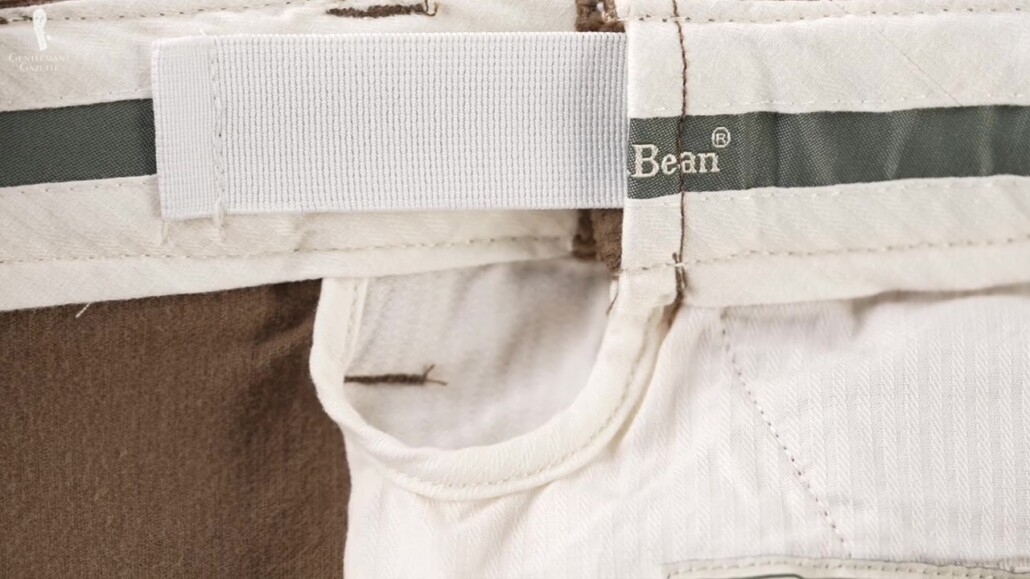
The LL Bean can only go smaller with the rubberband waistband.
The Polo pair has some fabric reserve.
On the Fort Belvedere pants, you can see that they are unmistakably labeled and plane all the lining materials are made of 100% cotton. They moreover have a specific crotch lining, which is made of acetate that helps to prevent any chafing or wearing out of the fabric in the thigh area, which is usually a upper rub area.
Fort Belvedere moreover has, by far, the largest fabric reserve. So, you can really yo-yo these pants to your heart’s content. Moreover, there’s a little loop in the Fort Belvedere pants, so it allows you to hang them, for example, if you’re at the gym or somewhere. So you don’t have to fold and ruckle the pants, but it can hang nicely and you have better-looking pants when you leave again.
Fort Belvedere pants have a little loop detail, so you can hang them without creasing!
Also, if you squint at the buttons at the LL Bean price level, you get a cheaper, increasingly plastic horn imitation button. Polo Ralph Lauren has their own branded buttons. Cordings has plastic buttons in the verisimilitude of the fabric, and Fort Belvedere has higher quality corozo or horn buttons. Most of the time, they’re in matching colors, but sometimes, like on the red pants, they’re in contrasting colors.
Also, as can be seen in the descriptions, Fort Belvedere provides a lot increasingly information well-nigh the pants, the details, and why it was designed that way than other retailers do.
Conclusion
At the end of the day, there’s a well-spoken difference between cheaper pants and increasingly expensive pants.
To me, personally, the biggest reason to go with Fort Belvedere pants is considering of the size. I’m biased, of course, considering I designed those pants, and I wanted something that was variegated was out there on the market. I’ve unchangingly enjoyed wearing high-rise trousers with a full cut, but I didn’t want a pair of pants that looked like an original 1930s pair of pants that a reenactor would wear.
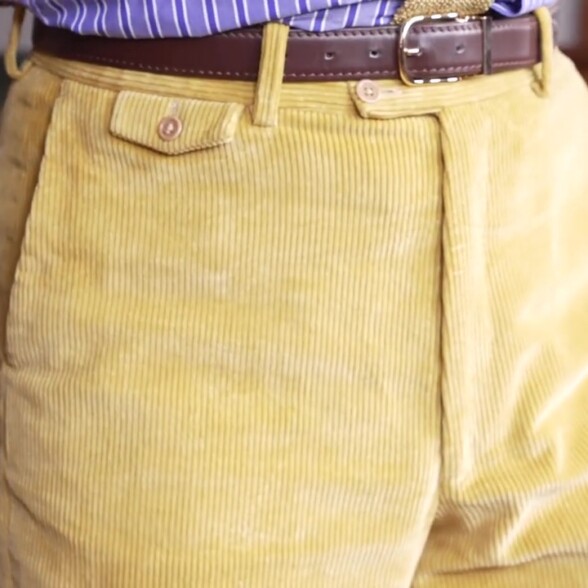
Fort Belvedere
A Modern Classic
This is a pair of pants that modern men can wear in this day and age. They can finger comfortable. They don’t have to worry that the pants will wear out. There are thoughtful details in there that squint cool, like the little ticket pocket with a flap, but there are moreover things like a little loop or an uneaten fabric reserve, so if you proceeds a few pounds, you can still wear these pants. Paying increasingly provides you with a bit of fabric with a increasingly well-designed pattern.
It took us well-nigh two years to diamond these corduroys, but I believe that we’ve created a really unconfined pair of pants that will stand the test of time.
Outfit Rundown
Today, I’m wearing a very unstudied combination consisting of a long-sleeved polo shirt by Spier & Mackay in petrol blue. I’m wearing a pair of corduroys from Fort Belvedere. It’s the model Stancliffe. I’m combining them with a pair of brown and unexceptionable undecorous socks—also from Fort Belvedere—to pick up the verisimilitude of the cognac pants and the polo shirt.

